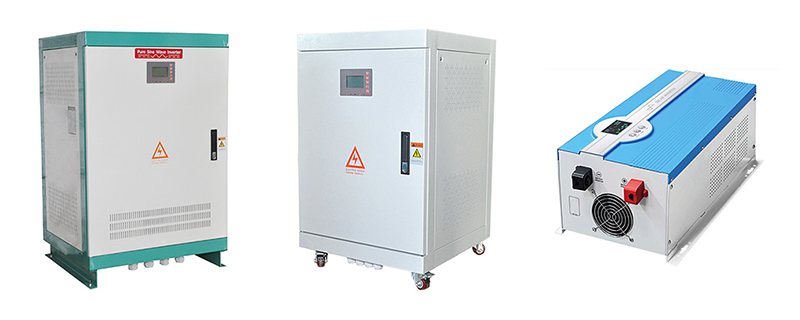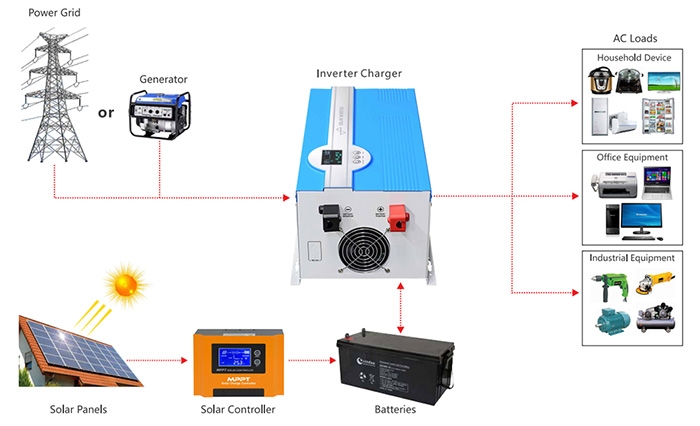In today's energy sector, off-grid inverters, as essential energy conversion devices, are widely used in areas without grid coverage or with unstable grids. Whether it is residents in remote mountain regions, outdoor adventures, or emergency rescue sites, off-grid inverters play a crucial role. With the proliferation of renewable energy, more and more people are opting for off-grid systems to achieve a self-sufficient energy supply. Off-grid inverters play a key role in these systems by converting the direct current generated by solar panels or wind turbines into alternating current usable by households and businesses. However, with the wide variety of off-grid inverters available on the market, how to choose an off-grid inverter that suits your needs? Inverter.com today will provide a detailed analysis of the key factors and tips to consider when selecting an off-grid inverter.
What are the basic functions of an off-grid inverter?
The primary function of an off-grid inverter is to convert direct current (DC) into alternating current (AC), allowing household appliances and devices to operate normally. When selecting an off-grid inverter, the first thing to check is its conversion efficiency to ensure maximum utilization of the generated energy. Some off-grid inverters also integrate a charge controller, which can directly manage the charging and discharging process of the battery. This is crucial for maintaining battery life and system efficiency. Many modern off-grid inverters support multiple operating modes, including pure off-grid mode, grid-tied mode, and hybrid mode. Understanding these modes can help choose the most suitable inverter based on specific needs.

What are the key factors in choosing an off-grid inverter?
- Power Requirements: Before selecting an off-grid inverter, it is crucial to determine your power needs. Different scenarios require different inverter power capacities. For instance, an inverter for home use might need to support various appliances such as TVs, refrigerators, and washing machines, whereas an outdoor adventurer might only need to power a laptop, phone, and other electronic devices. Therefore, choose an inverter based on your actual power requirements. Generally, inverters have two power ratings: rated power and peak power. Rated power refers to the continuous power the inverter can stably output, while peak power indicates the maximum power it can output for a short period. When selecting an inverter, focus on the rated power to ensure it meets your long-term power needs.
- Input Voltage: The input voltage of the off-grid solar inverter must match the voltage of the battery system. Common battery voltages include 12V, 24V, and 48V. Choosing the appropriate input voltage can improve system efficiency and extend the lifespan of the equipment.
- Output Waveform: The output waveform of the inverter significantly impacts the operational stability of the devices it powers. Common inverter output waveforms include sine wave, modified sine wave, and square wave. The sine wave output is the closest to the grid power waveform and is suitable for all types of electronic devices. The modified sine wave output, though different from the pure sine wave, can meet the operational needs of most electronic devices. The square wave output, however, is rougher and might damage sensitive equipment. Therefore, choose the appropriate output waveform based on your actual needs.
- Efficiency and Stability: The conversion efficiency of an inverter refers to the extent of energy loss when converting DC to AC. Higher conversion efficiency means less energy loss during conversion, resulting in greater energy savings. Therefore, when choosing an off-grid inverter, pay attention to its conversion efficiency and opt for products with high efficiency. The stability of an inverter is directly related to its lifespan and performance. When selecting an off-grid inverter, consider its safety features such as overload protection, over-temperature protection, and short-circuit protection. These features ensure that the inverter can automatically shut off output in abnormal conditions, safeguarding both equipment and personnel.
What are the tips for choosing an off-grid inverter?
- Output Voltage and Frequency: The output voltage and frequency of the inverter should match your load requirements, typically aligned with your country's standard mains voltage and frequency. Ensure the inverter you choose can provide the necessary voltage (e.g., 120V or 230V) and frequency (e.g., 50Hz or 60Hz).
- Type of Inverter: Consider whether you need a pure off-grid inverter, a grid-tied inverter, or a hybrid inverter. Hybrid inverters are versatile, offering AC backup power connections that allow them to bypass the grid to power loads when solar power is insufficient and batteries are depleted. They can also charge batteries using an AC backup power source.
- Output Power Capacity: Calculate the total power consumption of your appliances, considering both continuous and surge loads (especially for inductive loads like motors). Choose an inverter with a power capacity 10-20% higher than your total load requirement. For instance, if your load is 5kW, opt for an inverter with a capacity of at least 6kW. For smaller loads, consider a multi-function inverter/charger from 700 watts to 6000 watts to ensure adequate supply.
- Input DC Voltage: Select an inverter with a DC input voltage range compatible with your battery setup. The inverter's specification sheet will list the acceptable DC voltage range, which must align with your battery bank voltage. For larger systems, consider a three-phase pure sine wave inverter with high power from 8kW to 200kW to meet higher energy demands.
- Built-in Solar Charge Controller: Inverters with built-in solar charge controllers can be either MPPT (Maximum Power Point Tracking) or PWM (Pulse Width Modulation). MPPT controllers are more efficient, converting higher solar panel voltage to a lower battery voltage with minimal losses. Although MPPT controllers are costlier, they offer superior performance. Properly sized PWM controllers can also be effective but may not match MPPT efficiency.
- Battery Charging Requirements: Ensure the inverter's battery charging parameters, such as maximum charging voltage and cutoff voltage, are compatible with your battery specifications. Proper alignment ensures efficient and safe battery charging.
- Solar Panel Compatibility: Verify that the maximum DC output voltage of your solar panels does not exceed the inverter's maximum DC input voltage. Additionally, ensure the inverter has sufficient MPPT trackers to handle the number of solar panel inputs, optimizing power point tracking and overall efficiency.
- Backup Power Integration: For systems requiring backup power, choose an inverter with a generator starter feature. This feature uses dry contacts to signal the generator to start when the battery voltage is low, ensuring continuous power supply.
How to maintain an off-grid inverter?
Regularly inspect the inverter's exterior to ensure there is no damage or abnormal conditions. Use a multimeter and other tools to check the inverter's output voltage and current, ensuring they are within the normal range. Check the power supply to ensure the inverter's power source is stable, and that the voltage and current meet the inverter's operating requirements. If the inverter malfunctions, inspect and promptly replace damaged capacitors, resistors, semiconductor components, etc. Pay attention to the wiring connections of the inverter to ensure they are secure and free of poor contact issues. Regular maintenance not only extends the lifespan of the inverter but also enhances the reliability of the entire off-grid system.

Choosing the right off-grid inverter is a crucial step in building an efficient and reliable off-grid system. By understanding the basic functions of the inverter, considering key factors, and mastering selection techniques, you can better meet the energy needs of your home or business. When making a purchase, select the appropriate product based on your specific requirements and focus on professional installation and regular maintenance to ensure long-term stable operation of the system. Off-grid systems not only achieve energy self-sufficiency but also effectively reduce dependence on the traditional power grid. We hope this article provides valuable insights for you in selecting an off-grid inverter and helps you build an ideal off-grid energy system.
